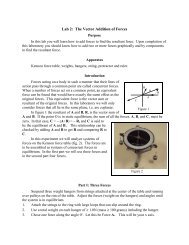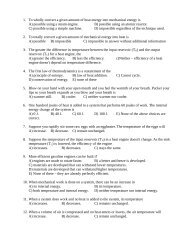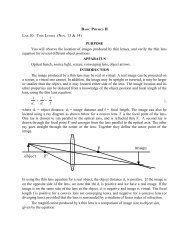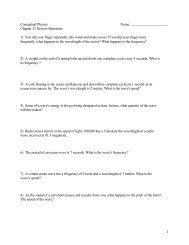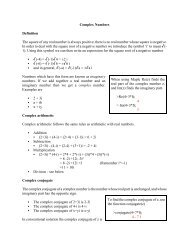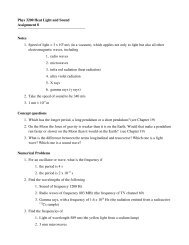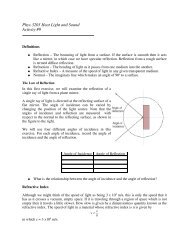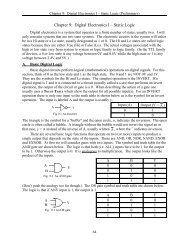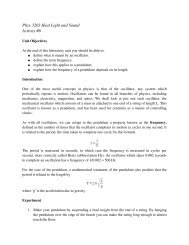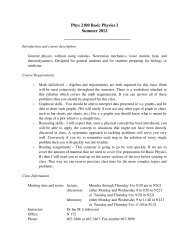Chapters 16 & 17 - Physics
Chapters 16 & 17 - Physics
Chapters 16 & 17 - Physics
You also want an ePaper? Increase the reach of your titles
YUMPU automatically turns print PDFs into web optimized ePapers that Google loves.
Basic <strong>Physics</strong> II AssignmentsFall 2011Chapter <strong>16</strong>: Electric Fields and Charges − Due Friday, September 21. How many protons does it take to make up 2µC of charge?2. Charges of 1µC and 3µC each exert a force of 0.3N on each other. How far apart are they?3. Three charges of 1µC, 2µC and −3µC are in a row and are 0.6m apart. Q 2Q -3Qa) What is the net force on the right charge (−3µC)? (Include thedirection.)0.6m 0.6mb) What is the net force on the middle charge (2µC)? (Include the direction.)4.* A charge of Q is at the origin, x=0, and a 3Q charge is at x = d. If I place a third charge q atx=b, the net force on each of the first two charges is zero. Find q in terms of Q and find bin terms of d.5. Three charges are located at the corners of asquare of side a. Find the magnitude and directionof the net force on the charge –Q due to the othertwo charges. Let the horizontal direction be x andthe vertical direction be y.-3Q6. Two charges are located at the opposite corners+12µ Cof a rectangle as shown at the right.6mAa) Find the components of the electric field atythe corner A. Let the x-axis be horizontal 3mand the y axis be vertical, as shown.xb) Find the magnitude and direction of that-9µ CElectric Field.+y7. Two charges are located as shown at the right,4m +2.5µ C−3.6µC at (−3m,0m) and +2.5µC at (0m,4m).a) Find the x & y components of the electric field-3.6µ CPat point P (x=3m, y=0).+xb) Find the magnitude and direction of the electric-3m 0m 3mfield.8. The electric field just outside a conductor is 400N/C. What is the surface charge density onthe conductor?9.* The electric field due to a point charge has a magnitude of 200N/C at a distance x from thecharge. If I move 3m farther away from the charge the field is 50N/C. Find x.Chapter <strong>17</strong>: Electric Potential − Due Friday, September 91. If I have to do +1J of work to move 0.2C of charge from a potential of 2V to anotherpotential of V final . What is that final voltage?2Qa-Q
2. The electric field between two parallel plates is 400N/C. It takes 0.5J to move 0.1C fromone plate to the other. What is the distance between the plates?3. Two charges are located at the corners of a-9µ C 6mArectangle as shown.a) Find the electric potentials at A and B.3mb) How much work would I have to do to move acharge of – 2mC from A to B? (Note that it is+6µ Cthe work I have to do.)B4. An electron is 0.053nm from a proton.a) What is its electric potential energy there? Give it in Joules and in eV. (On averagethe electron in hydrogen is about 0.053nm from the proton.)b) What would be the electrons potential energy if it were moved very far away, i.e. toinfinity?5. Three charges are located at the corners of an equilateral triangle of side d. The charges are+Q, +2Q and -2Q.a) What is the electric potential energy of this configuration?b) How much energy would I have to add to separate these charges, i.e. make d →∞?6. Two parallel conducting plates are 0.7mm apart. The area of each plate is 7.9cm 2 . What isthe capacitance of this configuration?7. The potential difference between the plates in the capacitor above is 9V.a) How much charge is on the plates?b) What is the electric field between the plates?c) How much energy is stored in the capacitor.8. I have two parallel plates arranged so that their capacitance is 4nF (n=nano = 10 -9 ) whenthere is no material between the plates. I insert a dielectric between the plates (filling thevolume between the plates) and measure a capacitance of 200nF. What is the dielectricconstant of that dielectric?9.* Two charges are separated by a distance d. Theelectric potential at A between the two charges, Qand 3Q is 800V. What will the potential be half waybetween the two charges, i.e. at the midpointbetween them?QdAd/43Q10. I want to take an electron (M = 9x10 -31 kg, q= -1.6x10 -19 C) at restand give it a speed of 10 7 m/s. I will do this by letting itaccelerate from a plate at a potential of 0 volts to a plate at apotential of V 1 volts. What must the potential V 1 be to do this?0VElectronV 1



